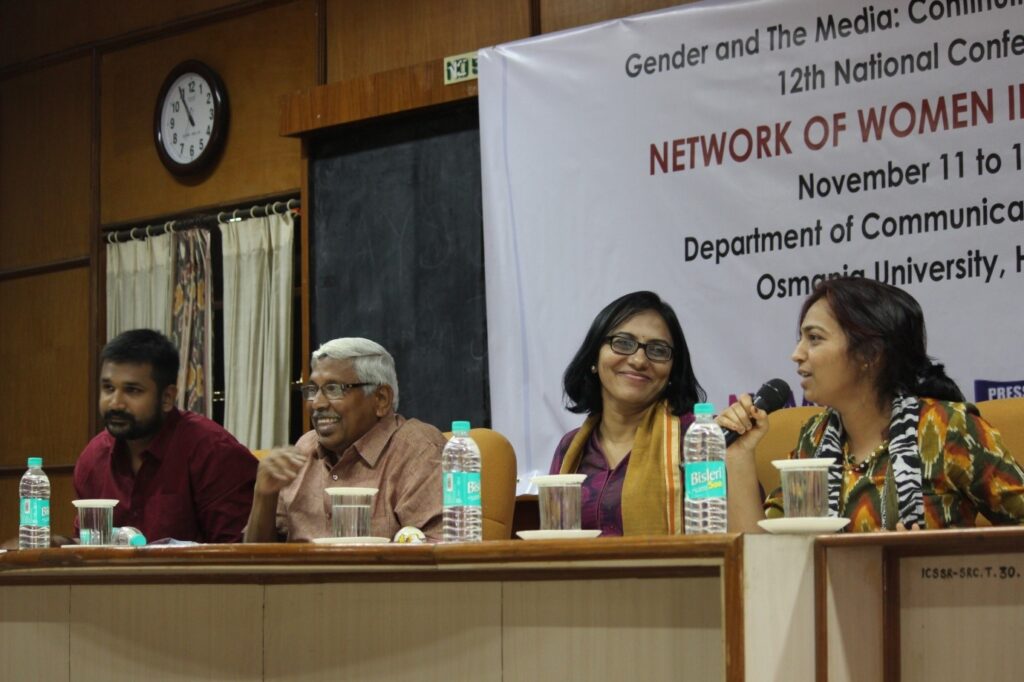SATURDAY, 12 November 2016, 9.30-11 am
Working Session 2: Is Small Always Beautiful?

The Osmania University Library building was an eminently appropriate venue for a discussion on the movement for a separate Telangana state. Chairing the session, NDTV Resident Editor Uma Sudhir drew attention to the fact that the Arts College was the hub of the movement which led to the formation of Telangana state in 2014. Her provocative remark, “When English becomes ‘national’, every other language becomes ‘vernacular’,” set the tone for the panel discussion by seasoned analysts and activists on whether the reorganisation of states and the creation of smaller ones are always beneficial for the people in whose name it is done.
Eminent political scientist Prof M Kodandaram, chairman of the all-party Telangana Political Joint Action Committee (T-JAC), which was formed to fight for a separate Telangana state, began by questioning the title of the session: how small is ‘small’ and is it not limiting to talk about state reorganisation in terms of size? He pointed out that each region has its own specificities, but the assertion of a regional identity is often seen a threat to the national identity, and to the very integrity of the nation. While the colonial state was organised for ease of economics and administration, Jawaharlal Nehru was of the view that different languages and cultures contribute to a diverse, cosmopolitan culture, which was desirable. On the other hand, B R Ambedkar’s understanding of the states question was that a political plan should take into consideration the social reality. Prof Kondandaram proceeded to provide a brief history of the Telangana movement, starting with the agitation against non-mulkis (locals) soon after Independence.
Bringing the discussion back to the present and examining the impact of the new state, Uma asked whether governance in Telangana was really reaching the people, and whether the problem of landlordism – for example – has been tackled. She pointed out that the dream of the movement was not only a physical, geographical Telangana state, but the promise of social and economic justice. She recalled that non-party formations – caste associations, student bodies and professional groups – were instrumental in achieving in the goal of a separate state. She also highlighted the participation of women activists on the roads, in rallies, weaving flags, etc.
Prof Kondandaram agreed that the role of non-party forums was very important in politics, especially in Telangana, where there is a real possibility of intervening at the public policy level. He pointed out that Telangana is an important model in state formation because of the following features: respect for non-party forums; accepted leadership at every level; powerful networks in every district; and immense public mobilisation and support.
Rama Saraswati, a journalist working with Sakshi, a Telugu daily, threw light on the language issues that were reflective of growing insularity. She related her experience with her earlier newspaper, Namaste Telangana, saying that the word ‘dawakhana’ – the Persian-derived term for hospital – was not encouraged even internally. Even the name of a features page, ‘Zindagi’, was frowned upon as being targeted to Urdu speakers alone, even though Dakhani (the local version of Urdu) is widely spoken by both Muslims and non-Muslims in the region. Rama also highlighted the fact that there was very little coverage of the Telangana movement in the ‘mainstream’ Andhra newspapers. So, as far as the media is concerned, small is definitely beautiful, she said. Commenting on the wide gap between ‘universal truths’ and ‘local truths’ as portrayed in the media, Uma invited the next speaker to share his experiences.
Recounting how student activists were branded as vandals and Maoists, Krishank Manne, a student leader now associated with the Congress Party, said that the demand for a separate Telangana state was not an emotional issue, but one based on rational factors. He lamented the sea change in the atmosphere of the very place we were gathered in. Osmania University, the vital core of the movement, where students had been lathi charged in February 2014, now did not allow protests or even the chanting of slogans on campus. He also decried the use of public money for pilgrimages and changes in government buildings in accordance with vaastu. According to him, the elitist form of urban planning, with flyovers entailing the cutting of hundreds of trees, was not in tune with the notion of a separate state based on the promise of social justice.
In the discussion that followed, two vital issues were raised: Kochi-based environmental journalist Suchitra Vijayan questioned the land acquisition policies of the government under the first chief minister of Telangana, Kalvakuntla Chandrashekar Rao, or KCR as he is better known.According to her, the Polavaram Dam project across the Godavari river was anti-people, with two lakh Adivasis scheduled to be displaced. Another question from Kolkata-based journalist Rajashri Dasgupta about why women were not visible in the JAC, despite being active in the movement, led to a discussion about the marginalisation of women in mass movements.


